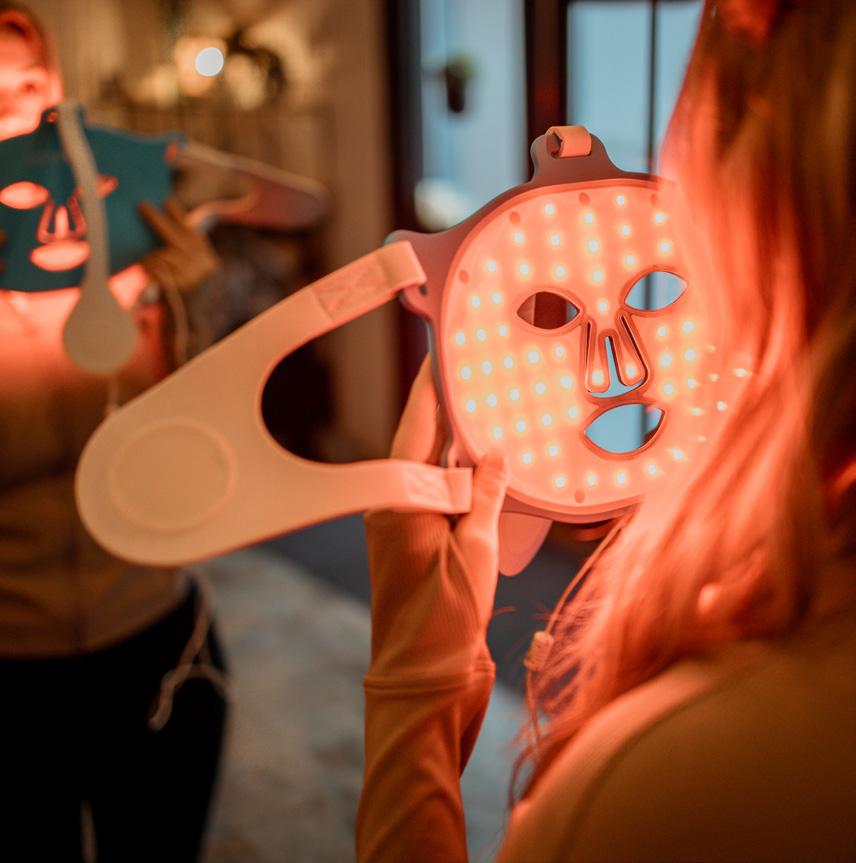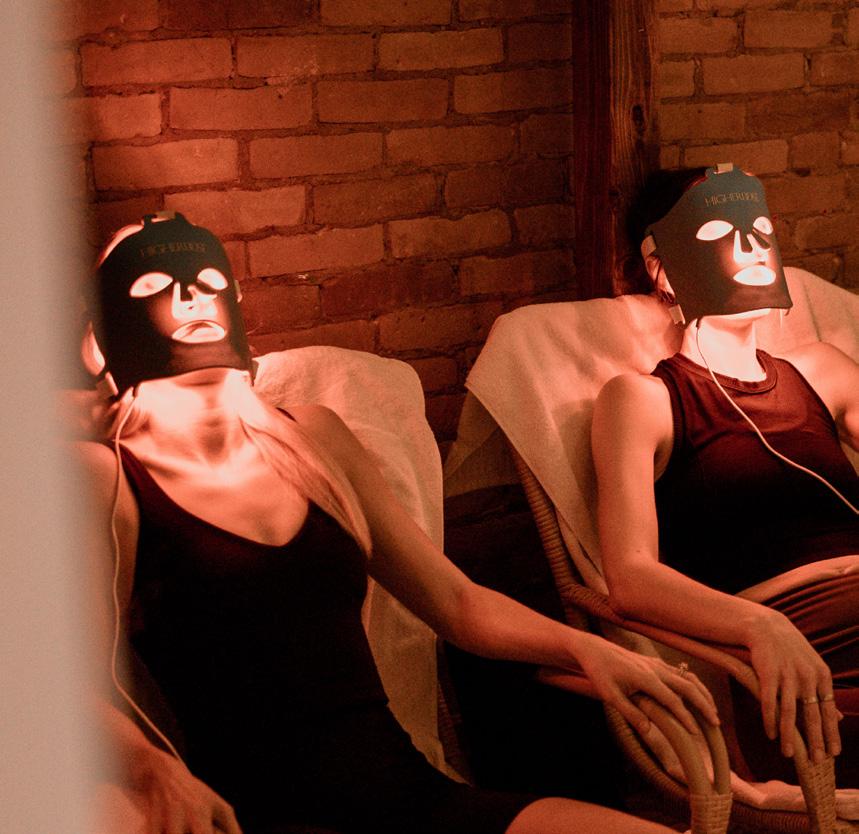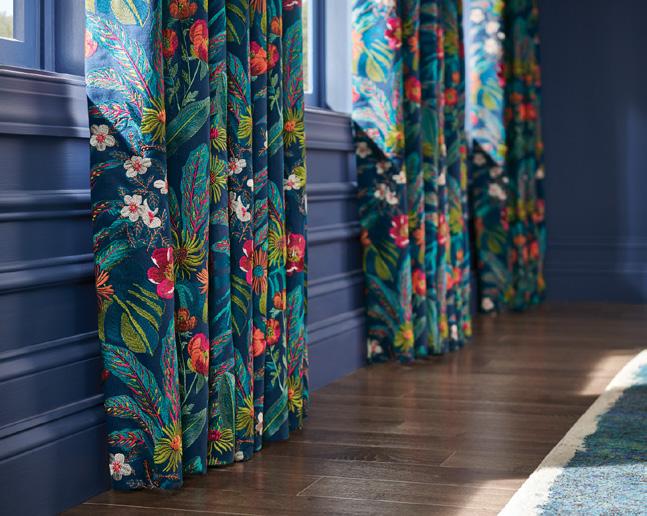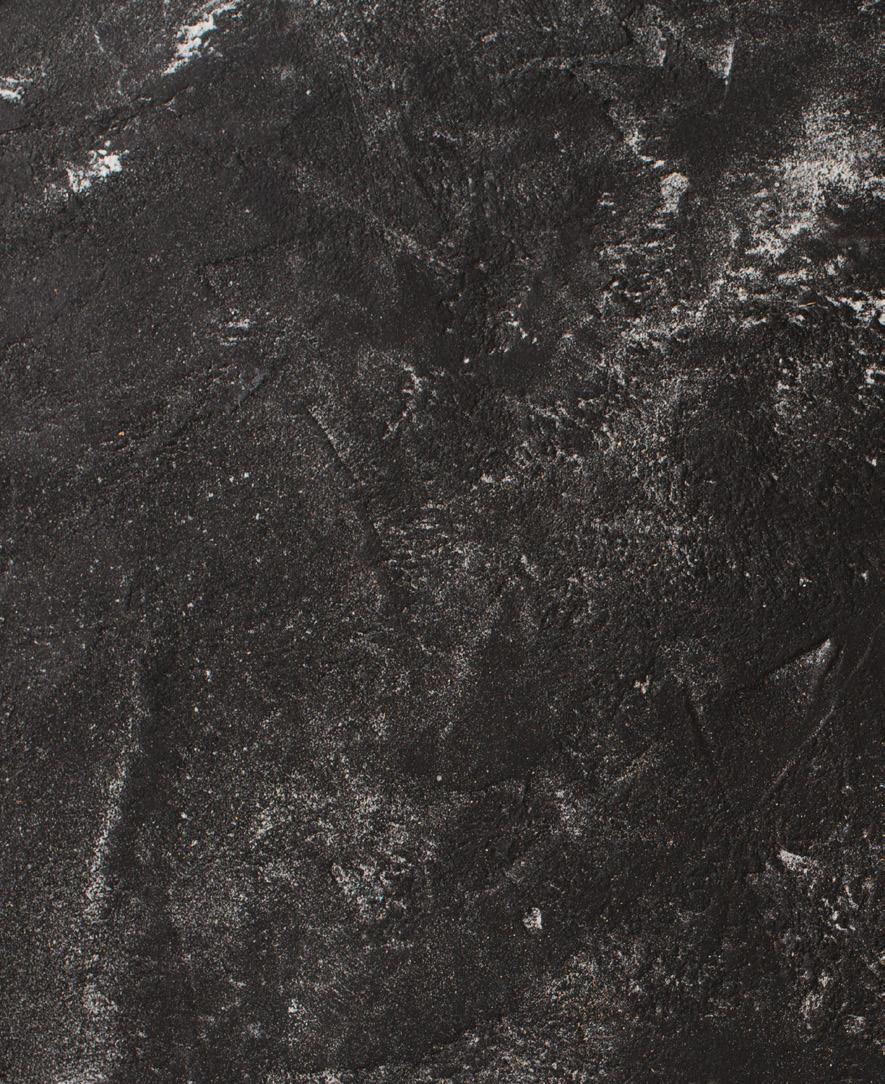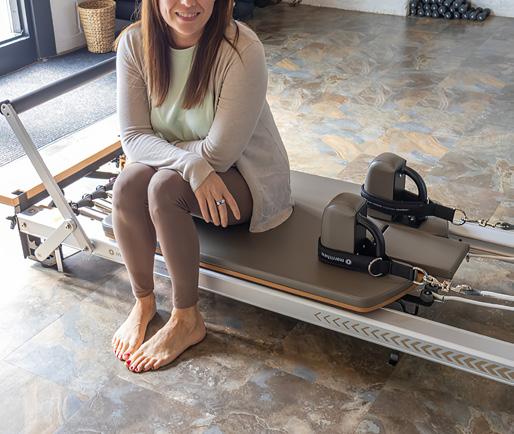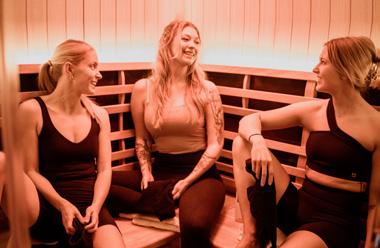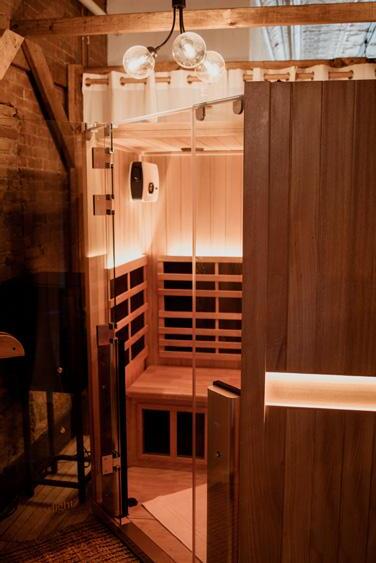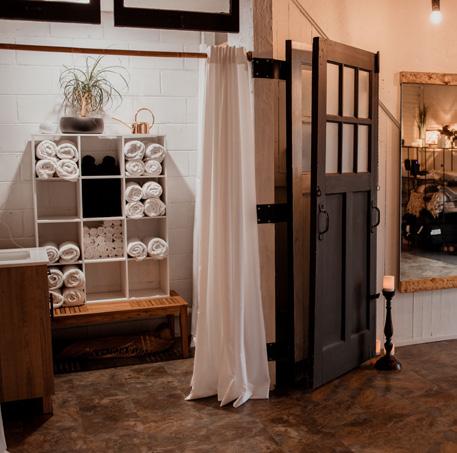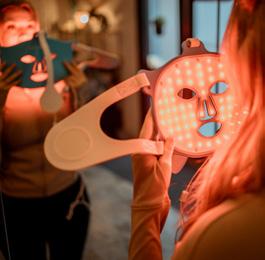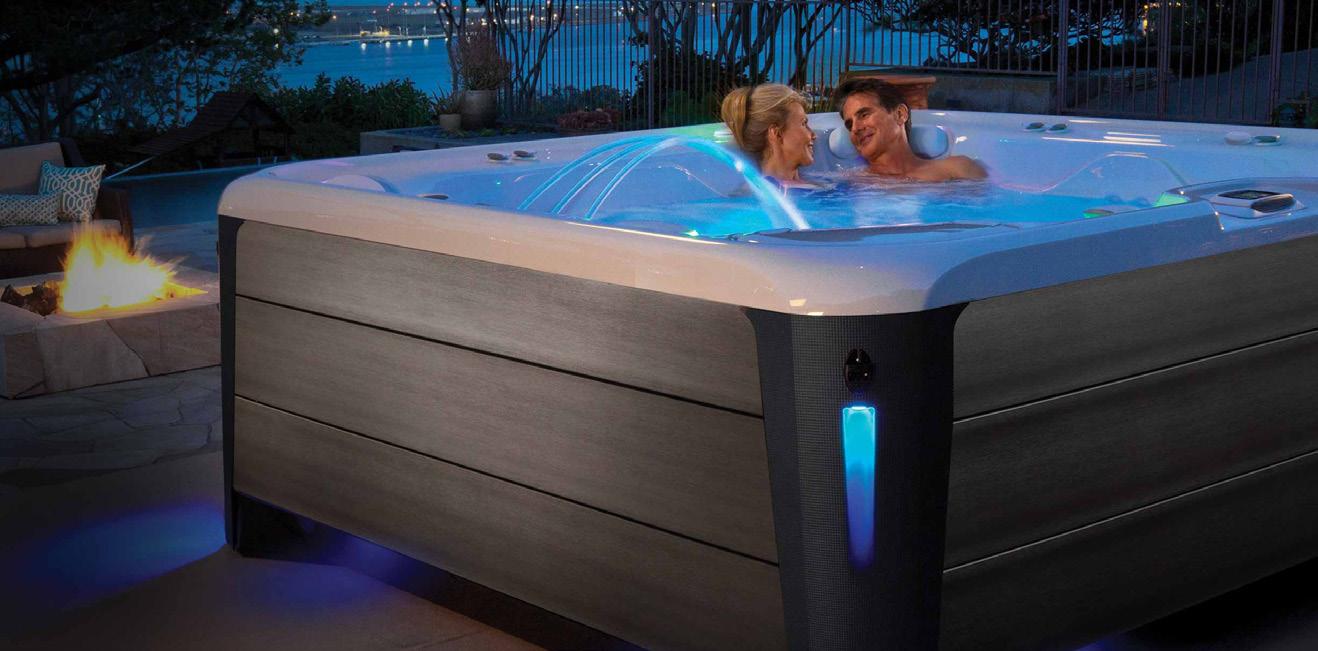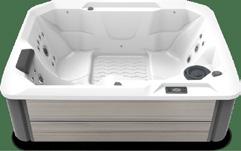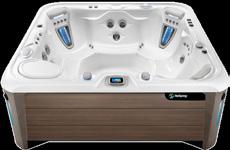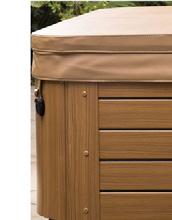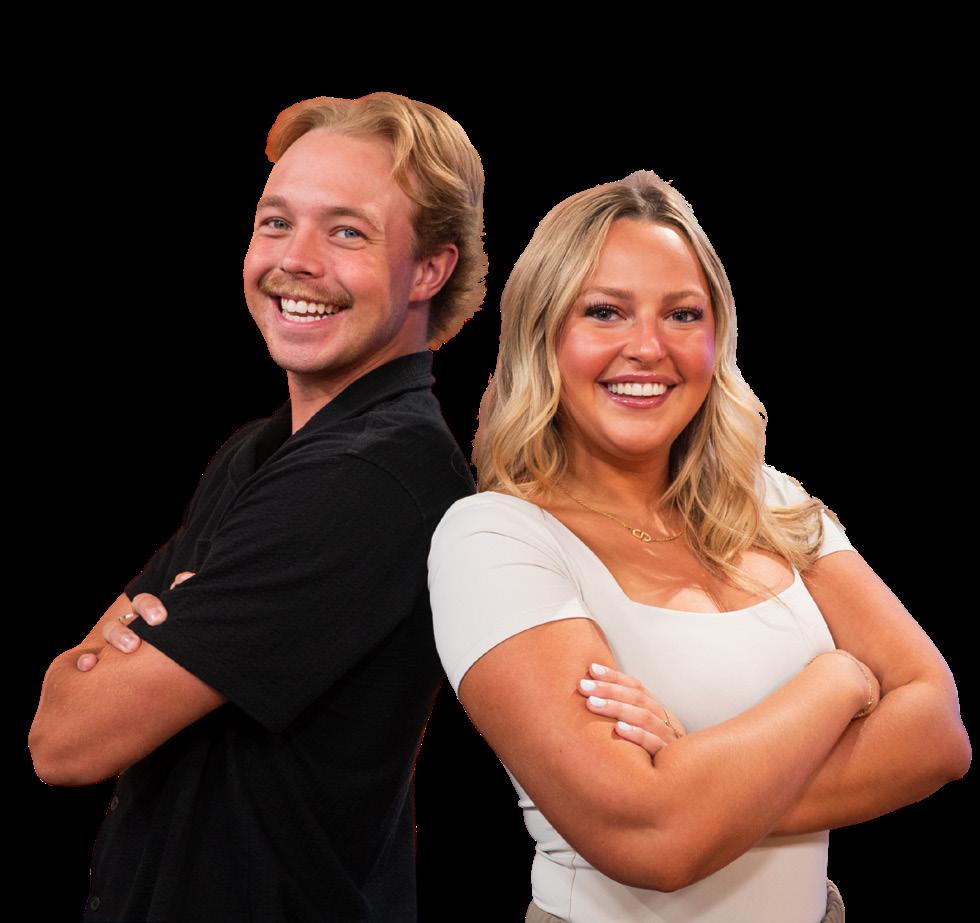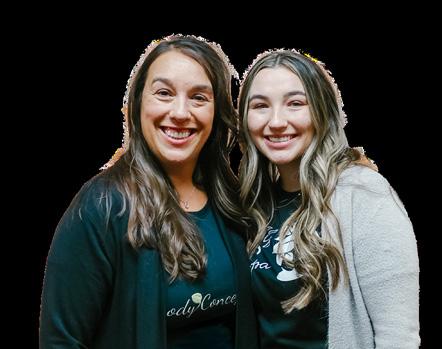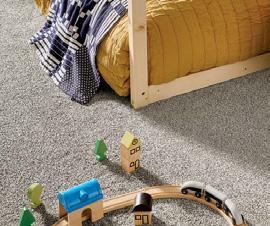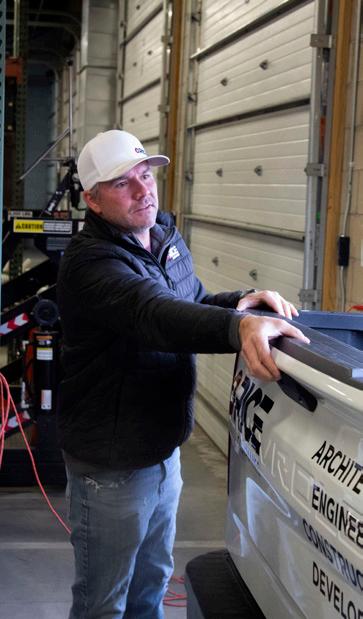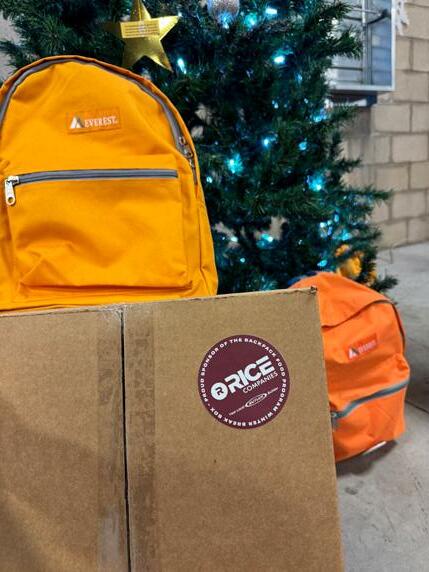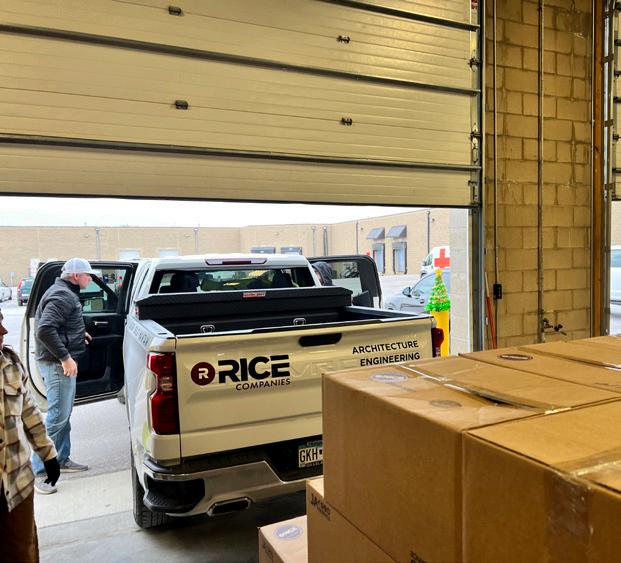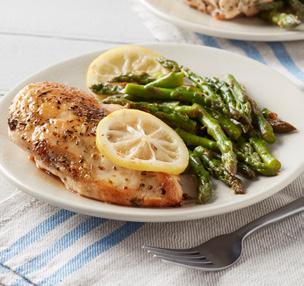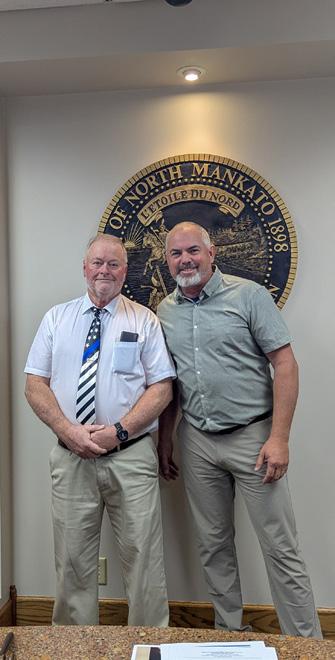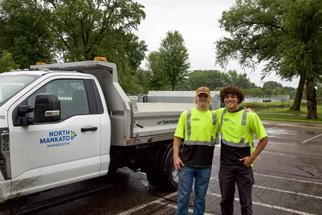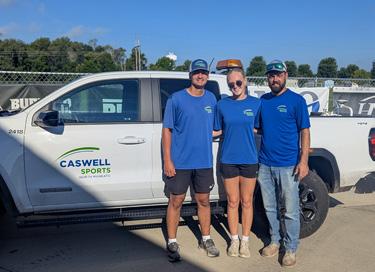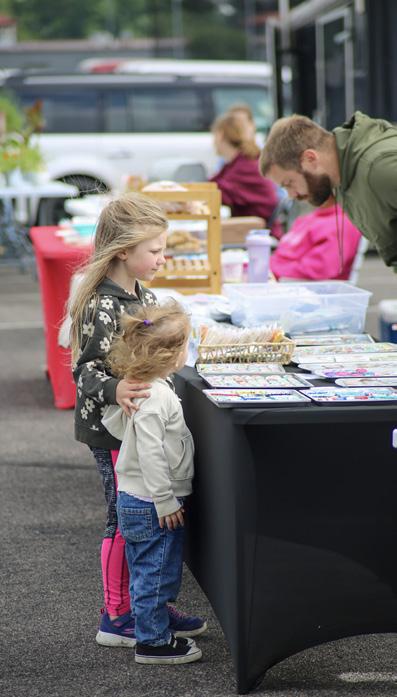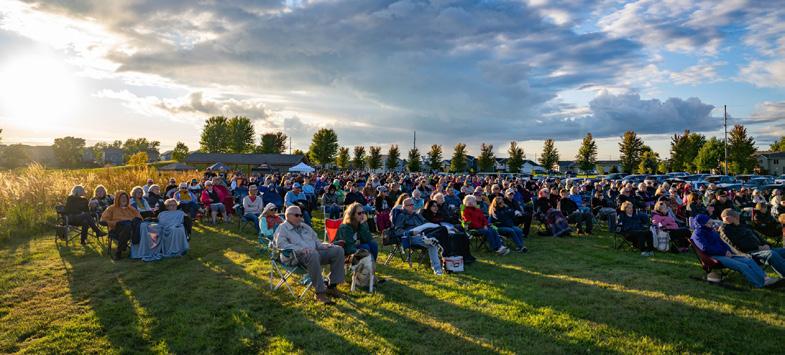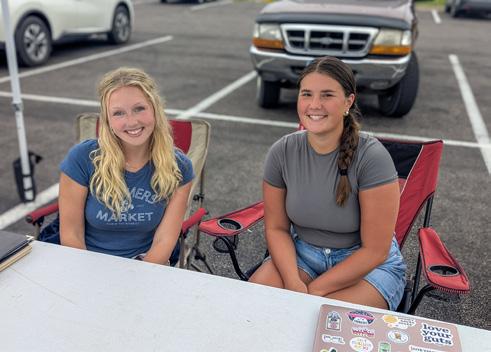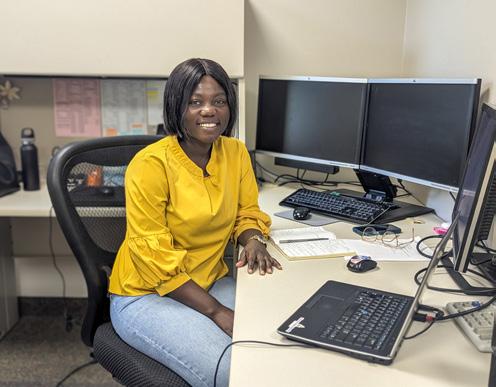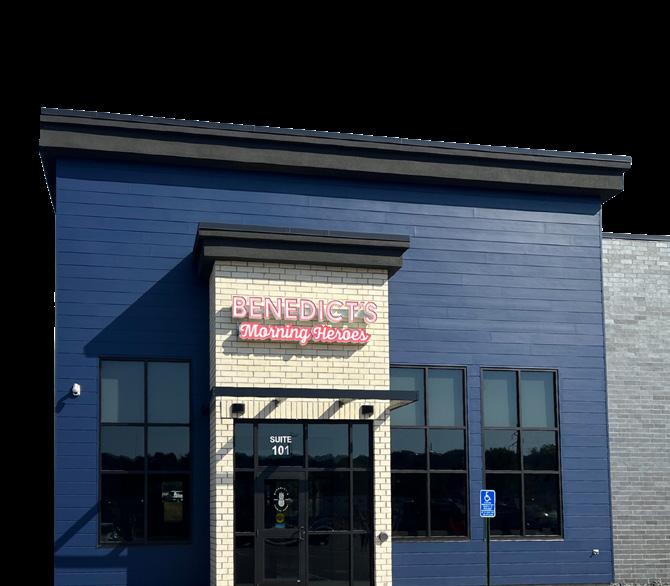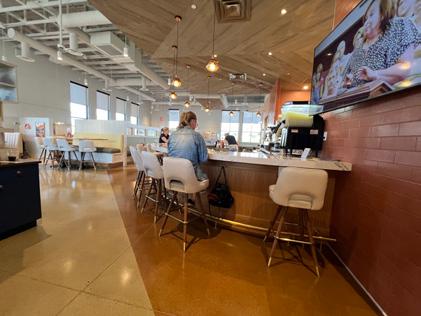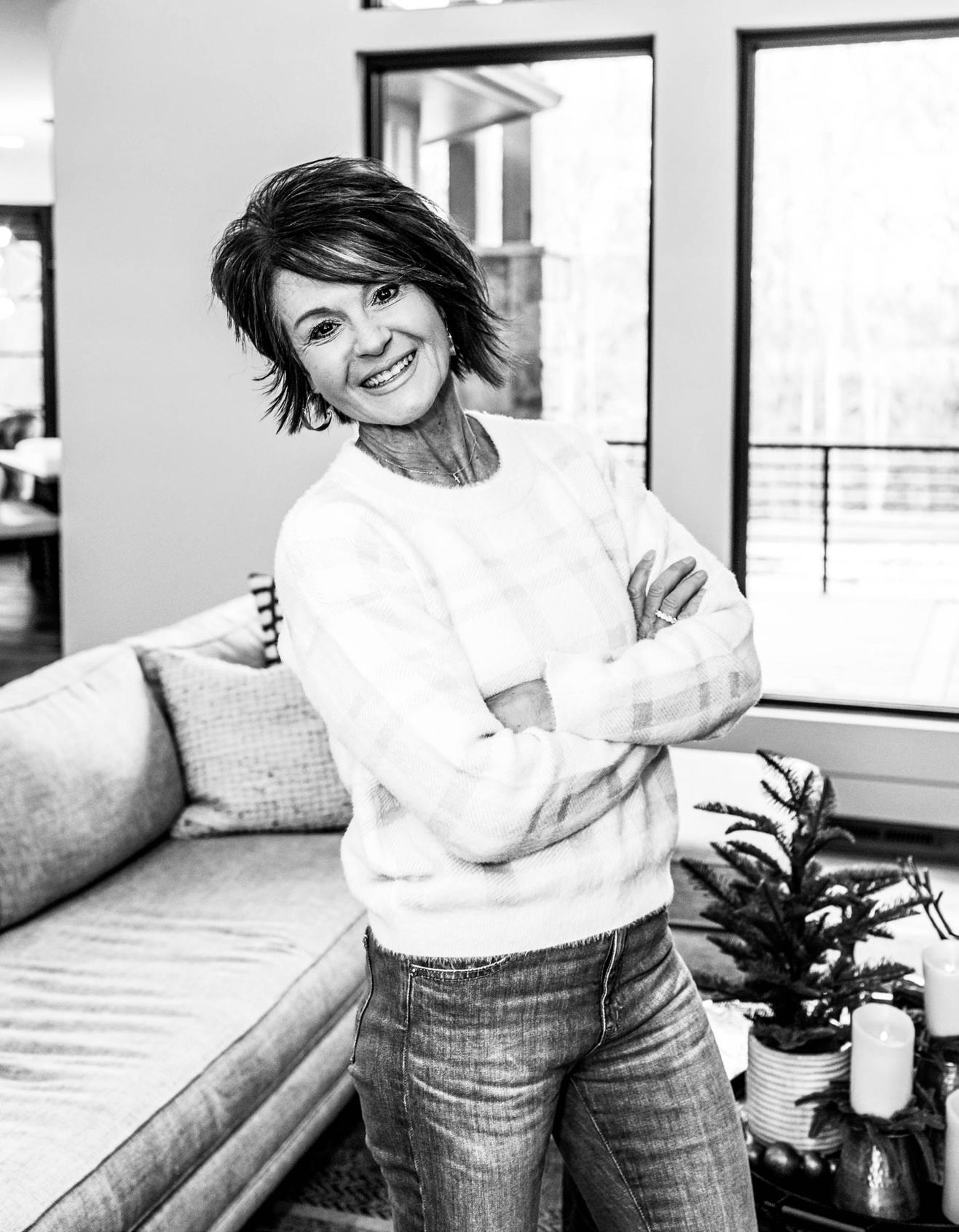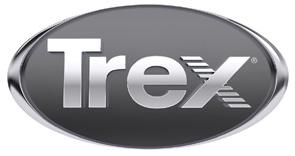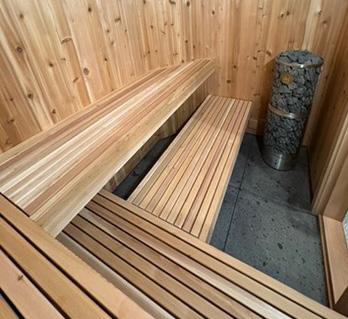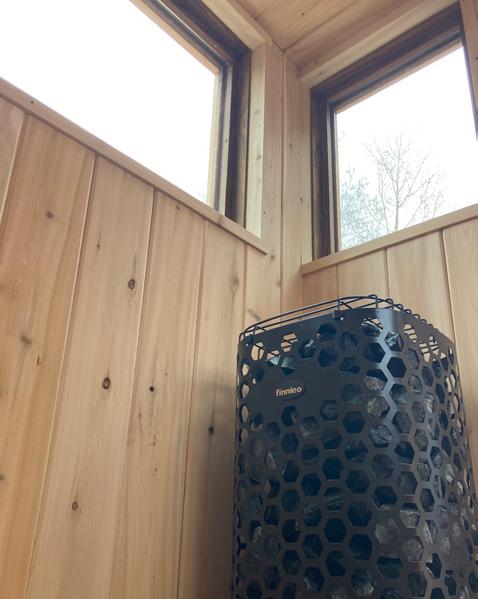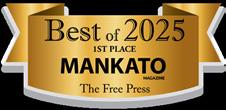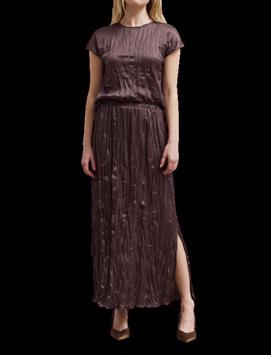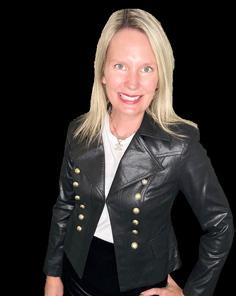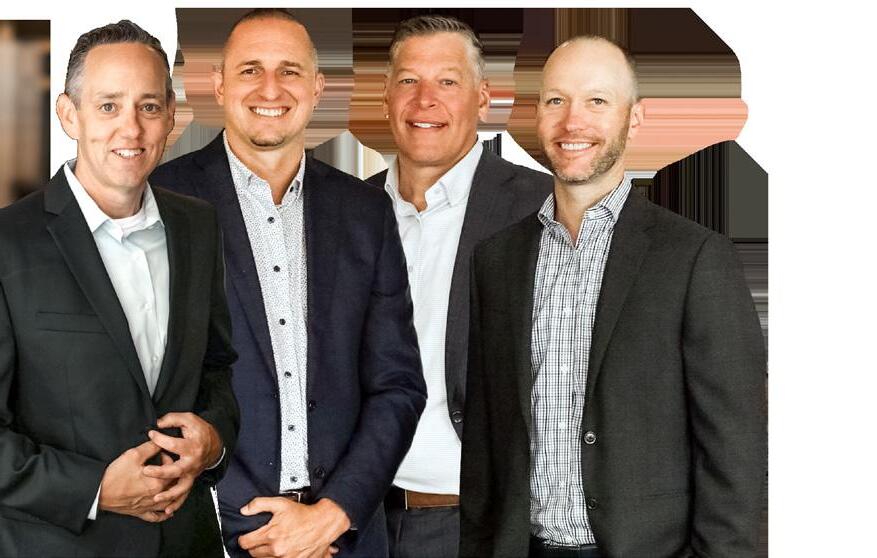FROMTHE EDITOR
At Luxe Quarterlies, we believe wholeheartedly in the power of print. There’s something special about holding a magazine in your hands, turning each page, lingering over a photo, and discovering a local story that speaks to you. In a world that moves at the speed of a scroll, print invites us to slow down, connect, and truly see the people and places around us.
After our last issue, I was reminded just how meaningful print can be. A North Mankato mom reached out to share that she discovered her 8-year-old daughter, Maude, creating an artistic collage full of pages from the magazine.
This wonderfully creative, young North Mankato resident, finding inspiration in print, beautifully captures why we do what we do. Stories live on when they’re shared, touched, and reimagined. Here’s to keeping that creative, community spirit alive one page at a time.
Priceless Indeed,
Holly Dodge, Editor
LUXE Quarterlies, LLC editor@luxequarterlies.com
North Kato Collage by Maude (8-years-old)
BY HOLLY DODGE
PHOTOS BY MANDY WILLIAMS PHOTOGRAPHY
hen you walk into Ember Wellness Studio along Riverfront Drive, it’s not just the scent of essential oils or the soft amber light that makes you exhale. It’s the feeling. The kind that reaches down and sparks something quietly smoldering inside you: the part that’s been longing to rest, to reconnect, to begin again.
For founder Nicole Panko, Ember was never just about saunas and Pilates classes or shelves of organic wellness products. It began as a small spark that flickered from a deeply personal journey through chronic illness, healing, and the slow rediscovery of what it means to truly feel well. “I didn’t really set out to start a business,” Nicole says, laughing. “It just kind of happened.”
Two years ago, Nicole opened the doors to Ember Wellness Studio, a wellness oasis tucked along Riverfront Drive. But the idea had been forming long before that, growing quietly out of her own transformation.
In her twenties, Nicole was diagnosed with scleroderma, a rare autoimmune disease that hardens the skin and restricts movement. “My body was literally turning to stone,” she recalls. “There were days I couldn’t even sit cross-legged or make a fist.” During her freshman year of college, she traveled every other day from Mankato to Rochester for treatment. “It was a hard time,” she says. “I was young, in the dorms, eating mac and cheese and trying to figure out who I was while my body was betraying me.”
Slowly, Nicole began changing her habits: first her diet, then her exercise routine, and then the products she used every day. “It’s been a long journey,” she says. “I didn’t wake up one day and decide to overhaul my life. I just made small changes, one at a time.” Those small changes would become the philosophy behind everything Ember stands for today: gentle shifts, conscious choices, and healing that begins from within.
Before opening Ember, Nicole’s professional world looked very different. She worked as an interior designer for Paulsen Architects in Mankato, helping shape some of the area’s popular and beautiful locations, including Number 4 Restaurant and Chankaska Winery.
“I’ve always loved creating experiences,” she says. “Designing spaces where people feel something.” That love for atmosphere and detail shines through at Ember. Every corner of the studio feels thoughtfully designed.
Before Ember, Nicole ran another small business. She managed the operations and began introducing wellness products into the space. “I was already on my own health and wellness journey,” she explains. “I started swapping out products for cleaner, more natural options.”
One day, a friend asked a question that would change everything: “Why don’t you take all this wellness stuff out and make it its own thing?”
At first, she laughed it off. “I said ‘no’ immediately. Double the overhead, double the stress, no way!” she says. “But the idea wouldn’t leave me alone.”
Soon after, a friend mentioned a vacant space downtown. “It just fell into my lap,” Nicole says. “Everything unfolded so naturally. Friends offered to teach yoga, others helped with classes, and it all just happened. The timing was right.”
From the start, Ember has been more than a fitness studio. It’s a wellness collective. It’s become a space that offers everything from reformer and mat Pilates, to yoga, barre, infrared sauna sessions, and even sound baths.
It’s also a place where tears aren’t uncommon. “I’ve had people start crying right on the reformer,” Nicole says. “Sometimes it’s pride. They finally made time for themselves again. Other times it’s release. It’s powerful.” She remembers a recent class where, at the end, one woman began to cry. “Then two others just reached out and hugged her,” Nicole says. “They told me, ‘Thank you for creating a space where we can be open and connect.’ That’s the kind of community I want to build.”
For Nicole, connection is the heartbeat of Ember.
“Everyone needs three places where they feel like they belong,” she says. “Home, work, and a third place. I want Ember to be people’s number three.”
In addition to Pilates and yoga, guests can experience:
Infrared sauna therapy, enhanced with color light (chromotherapy)
• Dry salt therapy, also known as Halotherapy, stimulates the body’s internal processes to cleanse the respiratory tract and strengthen lung function
• PEMF (Pulsed Electromagnetic Field) to stimulate and encourage your body’s natural recovery process
Barre classes that strengthen and tone without requiring a dancer’s background
• Energy healing, including Reiki sessions and sound baths that blend vibration and stillness
Mat Pilates for Active Older Adults to improve flexibility, core strength, and balance in a safe and supportive environment
Ember Wellness Studio NEW LOCATION
611 Riverfront Dr, Mankato, MN
Offerings include Pilates, yoga, barre, sauna therapy, energy healing, and holistic retail.
emberwellnessmankato.com Visit us online to learn more and book classes
And for many, it is. “We’ve had clients tell us, ‘I wouldn’t have made it through my divorce without this community,’ or ‘You guys got me through the hardest summer of my life.’ That’s what keeps me going.”
Today, Ember Wellness Studio is a multi-sensory retreat featuring more than ten instructors with many offerings throughout the week.
There are memberships for the devoted, class packs for the curious, and drop-in options for those who simply want to try it out. “We wanted it to be accessible,” Nicole says. “If you just want to try one class, you can. You don’t have to make a huge commitment.”
Ember also hosts monthly workshops and pop-ups,
including IV infusions and menopause specialists, as well as lunch-and-learn events. “We love partnering with other local practitioners,” Nicole says. “Collaboration is a big part of what we do.”
Balance, of course, is at the heart of everything she teaches. Nicole has made Ember a space where people are reminded of their own strength, as well as their softness.
For many, a visit to Ember is the first step on a new path. Maybe it’s a drop-in class after a long period of neglecting self-care. Maybe it’s a sauna session that leads to reflection, or a sound bath that brings an unexpected release.
Two years after opening, Ember is growing again. The studio recently purchased the building next door to its current location on Riverfront Drive. The new space is three times larger and is scheduled to open later this fall.
“We’re moving into 611 Riverfront, right next to Nicollet Bike Shop,” Nicole shares. “It’s been a family project. My husband Jim, my parents, even the kids have been helping.”
Inside, the new Ember will feature expanded class areas, a strength-training zone, more reformers, a larger retail section featuring low-toxin and eco-conscious products, a grab-and-go café, and a coffee shop. Nicole has partnered with Maeze Coffee to bring a full espresso bar right inside the wellness studio. “You can come in for a coffee, relax, or just browse.”
“Everything we carry is carefully chosen,” Nicole explains. “We focus on non-toxic, no-microplastic, hormone-safe products. Things that align with how we live and what we believe in.”
Behind all the growth and gorgeous design, Nicole’s world is full. She and her husband, Jim, met at Paulsen Architects, where she had once designed interiors. They married in 2014 and today, they’re raising three boys: her stepson, 21; and two younger sons, ages 10 and 8, both athletes who share their parents’ work ethic.
“Our family spends a lot of time at the studio,” she says. “The boys love the reformers. They’re both hockey players, so we focus on strength and flexibility for their sport. And we all do the sauna together. It’s kind of become our Sunday ritual.”
When she’s not teaching or managing Ember, Nicole enjoys unwinding with a good massage or spending quiet time with her family. “I’m learning to slow down,” she admits. “I used to be all go-go-go. Now I’m trying to find balance.”
“I think people come here expecting a workout or a treatment,” she says, “but they leave feeling something deeper– like they reconnected with themselves.”
Every class, every product, every design choice serves the same mission: to nurture both body and spirit. “Pilates, for example, was designed by Joseph Pilates to make everyday life easier,” Nicole explains. “The goal isn’t to perform or be perfect, it’s to move better, live better. The quote I always share is: ‘After 10 sessions, you’ll feel the difference. After 20, you’ll see the difference. After 30, you’ll have a whole new body.’”
Her students see that truth come alive every day. “We’ve had clients tell us their back pain disappeared, or that they feel stronger than ever,” she says. “I’ve experienced that too. I have a whole new relationship with my body now.”
Perhaps what sets Ember apart most is its sense of belonging. It’s not unusual to see clients linger after class. “We’ve seen friendships form here that go far beyond the studio,” Nicole says.
That connection extends to the team as well. With more than ten instructors, each with their own expertise and warmth, the studio feels like an extended family. “We all support each other,” Nicole says. “Everyone is here for the same reason: to help people feel good.”
As Ember prepares to celebrate its two-year anniversary and move into a brand-new space, Nicole’s hope for the future remains simple: that people will continue to show up for themselves. “Just try it,” she says, “That’s what I tell everyone. We’re not intimidating. We’re welcoming. Take that first step. Come to a class, sit in the salt lounge, or drop by for a coffee. You never know what might change for you.”
Because sometimes, wellness doesn’t begin with a huge gesture or aperfect plan. Sometimes it begins with a small spark. A small, glowing ember. And when you tend to it with care, it can light the way to something extraordinary.
BY HOLLY DODGE
When the cameras start rolling on KEYC’s Kato Living, there’s an easy rhythm that settles over the set. Co-hosts Jackson Jirik and Mattea Skinner tease one another like close friends and they welcome guests with laughter and genuine curiosity. It’s easy to see, they are two people who not only enjoy what they do but also the community they get to represent.
But behind those thirty minutes of “organized chaos,” as Jirik describes it, are hours of preparation, countless moving parts, and a shared passion for showcasing the people, stories, and spirit that make southern Minnesota shine.
Jirik’s path to television wasn’t exactly linear. A native of New Prague, he first set his sights on conservation law while attending college in Stevens Point, Wisconsin. “I realized it wasn’t for me, so, I figured the next best thing would be sports and talking,” he says with a laugh.
That decision eventually turned into a serious career pursuit. After transferring to Minnesota State University, Mankato,
Jirik found encouragement from former anchor and Kato Living host, Lisa Cownie, who encouraged him to apply for an internship at KEYC. “She said I was good at it and should go for it,” he recalls. “I ended up getting the internship, and I was hired a week before graduation.”
Three years later, he’s climbed from a sports intern to morning news anchor and co-host of KEYC’s Kato Living, a lifestyle show that highlights Southern Minnesota.
Skinner’s journey began much farther south. “I grew up in Clear Lake, Iowa,” she says. “We moved to Mankato when my dad began working here. I went to Loyola, but at the time I wanted nothing more than to get out of Minnesota.”
That feeling led her to Texas for college at TCU, where she initially pursued pre-med. “That lasted about a week and a half,” she admits with a grin. “I started writing down what I actually enjoyed, and I realized I loved storytelling and connecting with people. That’s when journalism found me.”
Through her involvement in TCU’s newscast, Skinner discovered her natural ease on camera. Still, after four years away, she missed her family and the four seasons she grew up
with. When she saw an opening at KEYC, she jumped at the chance to return home. “It just felt right,” she says. “And being close to family again has been the best part.”
While Kato Living airs just half an hour a day, its production is anything but small. Jirik and Skinner effortlessly juggle writing, producing, editing, moving sets, and hosting the live recording.
“A typical day starts with producing the show,” Jirik explains. “We gather all the guest info, business names, events, make sure it looks and sounds good. It’s a lot of prep for a short show. I’d say it’s 80 percent preparation and 20 percent showtime.”
During taping, the pair is constantly in motion. “It’s organized chaos,” he says. “While I’m moving things around for the next guest, Mattea’s handling introductions or prepping the teleprompter. We’ve got a rhythm now.”
Skinner agrees. “People don’t realize how much happens behind the scenes. It’s a lot of work, but it’s so fun. You meet someone new every day, you get to learn about what they care about, and you get to have real conversations.”
The show, while polished on-screen, is filmed in one take, much like a live performance. “There’s no editing,” Skinner laughs. “It’s theater! You just have to go with it.”
One of the reasons Kato Living resonates so deeply with viewers is the authenticity of its hosts. Both Jirik and Skinner grew up nearby, and that local connection shapes the tone of every episode.
“We’re representing people we actually know,” Jirik says. “Our families watch the show, our friends see it. We don’t have to pretend to be anyone else.”
That relatability also helps dissolve nerves for them and their guests. “When you’re sitting there having a genuine conversation, you kind of forget the cameras are even there,” Skinner says. “That’s when the best moments happen.”
When asked about their favorite memories from the show, they both light up with stories.
“I think the moments that stand out are when you can tell someone’s really passionate about what they’re sharing,” Jirik says. “You can see it in their eyes. That’s the best part of our job. Helping people share what they love.”
Still, there are plenty of other highlights too. “We went ziplining once,” Skinner recalls. “That was awesome. And we’ve done everything from fishing and shooting at a gun range to trying incredible food. I booked so many food segments in my first two months. I was obsessed!”
Jirik nods in agreement. “We’ve probably tried hundreds of restaurants. I’ve discovered so many local gems I never would’ve found otherwise.”
Like anyone, they have their off days, but for TV personalities, there’s little room to show it.
“You really have to fake it sometimes,” Jirik admits. “If you’re tired, upset, or distracted, it can’t show. You’ve still got guests walking in who are excited to be there, and you owe it to them to bring that same energy.”
Skinner agrees, though she adds that teamwork helps. “We haven’t really had to do the show alone yet, but if one of us is off, the other picks it up. We balance each other out.”
Their camaraderie shines through not only on camera but also off it. “We work half a shift together,” Jirik explains. “I’m in by 4:45 a.m. for the morning newscast, and then I switch gears to Kato Living. Mattea comes in around eight, and she’s usually clipping and posting the show by afternoon.”
It’s a demanding schedule, but both insist the reward outweighs the grind. “Even on the longest days,” Skinner says, “it’s fun. There’s something new every single day.”
Despite the long hours, they each find ways to recharge.
“Outside of KEYC, I do play-by-play for MNSU sports football, volleyball, and soccer,” Jirik says. “I also ref middle school football, run social media for my baseball league, and play town ball. When I’m not doing that, I’m probably hunting or spending time with my girlfriend.”
For Skinner, returning to Minnesota has meant reconnecting with family and rediscovering her favorite outdoor pastimes. “I’m really close with my family, so spending time with them has been amazing. I love watching sports, movies, and doing anything with water. I grew up wakeboarding and surfing, and the first story Jackson and I did together was on a boat.”
She smiles at
“That’s when I learned how competitive he is. I didn’t want to show off, but I might be the better wakeboarder.”
Part of what makes Kato Living feel so personal is that both hosts bring their true selves to the show. “We don’t put on an act,” Jirik says. “The way we talk to each other on camera is exactly how we are off camera. You’d get the same version of us at a bar, a restaurant, or a ball game.”
That approachability extends to their audience. “When people recognize us in public, it’s so fun,” he says. “I’ll be at Kwik Trip and someone will say my full name: ‘Jackson Jirik!’ and I’m like, ‘Do I know you?’ It’s always really fun.”
For Skinner, those encounters are part of what makes the work meaningful. “It’s special when someone says they love watching Kato Living. It reminds you that people feel connected to what we do.”
Both agree that Kato Living stands apart from traditional news because of its focus on connection and positivity. “I love that we get to tell the good stories,” Skinner says. “So much news is heavy, but Kato Living is about what’s going right. The things that are creative, inspiring, and local.”
MORE THAN JUST A TURKEY DAY SNOOZER TRYPTOPHAN
As a registered dietitian, I can’t tell you how many times I’ve heard someone say, “It’s the tryptophan in the turkey that knocked me out after Thanksgiving dinner!” While there’s a kernel of truth in that statement, the full story of tryptophan is far more fascinating and useful than its sleepy holiday reputation suggests.
Tryptophan is an essential amino acid, which means your body can’t make it on its own. You have to get it from food. Once consumed, tryptophan gets to work behind the scenes, helping your body produce important compounds like serotonin (the “feelgood” neurotransmitter), melatonin (the hormone that regulates sleep), and niacin (vitamin B3, which supports energy metabolism and DNA repair).
So yes, it’s involved in sleep, but also in mood, memory, digestion, and even immune function. It’s a multitasker, and a pretty impressive one at that.
Now, about that turkey myth. Turkey does contain tryptophan, but so do many other protein-rich foods, and some of them have even higher amounts. Chicken, eggs, cheese, tofu, salmon, oats, and pumpkin seeds are all excellent sources. The reason you feel sleepy after Thanksgiving dinner probably has more to do with the sheer volume of food, the carb-heavy sides, and maybe a glass of wine or two. Tryptophan doesn’t act alone; it needs a little help from carbohydrates to cross the blood-brain barrier and be converted into serotonin. That’s why a cozy bowl of oatmeal with banana slices or a slice of whole grain toast
with peanut butter can be a surprisingly effective bedtime snack.
Tryptophan also plays a role in mental health. Research has shown that low levels of tryptophan may be linked to mood disorders like depression and anxiety. Because it’s a precursor to serotonin, getting enough tryptophan in your diet can help support emotional balance and cognitive function. Think of it as nutritional self-care for your brain. If you’re looking to boost your tryptophan intake this winter, try a warm lentil and turkey stew, roasted butternut squash with quinoa and walnuts, or a hearty bowl of chili made with black beans and lean ground beef. For a sweet treat, dark chocolate and dried dates both contain tryptophan, and they pair beautifully with a cup of herbal tea on a snowy evening.
And here’s a fun fact to share at your next holiday gathering: tryptophan was first isolated from casein, a protein found in milk, over a century ago. So that old-fashioned glass of warm milk before bed? It actually has some science behind it.
In short, tryptophan is a nutritional powerhouse that deserves more credit than just being the scapegoat for post-feast naps. It’s a key player in your body’s ability to feel good, sleep well, and stay balanced during the holidays and all year long.
BY HOLLY DODGE
When the sun rises, the aroma of freshbaked monkey bread and sizzling bacon drifts over North Mankato. By the time most people are brewing their first cup of coffee, the crew at Benedict’s Morning Heroes has already been in the kitchen for hours hand-mixing hollandaise sauce, baking biscuits, and slicing locally sourced pork from Compart Family Farms. It’s all part of what makes Benedict’s a new and special restaurant: real food, made from scratch, served with heart.
The Benedict’s story began far from North Mankato. Owners Mike and Abby Rakun, both veterans of the restaurant industry, opened the first Benedict’s in Wayzata in 2017. The idea came from a simple frustration: after long weekends in hospitality, the couple had nowhere to go for breakfast on Mondays. “All the restaurants were closed,” says head chef Keith Ludi, who now runs the North Mankato kitchen. “So, they started making pancakes at home. That’s how Benedict’s was born.”
That homemade beginning grew a breakfast brand with locations in Wayzata, Rochester, Fargo, and now, North Mankato.
When Benedict’s opened its doors in lower North Mankato in July of 2025, it was immediately clear that the community had been hungry for something new. “People were waiting for a good breakfast spot,” Keith says. “A lot of places in town do breakfast, but we wanted to raise the bar and provide something fresh, made inhouse, with local ingredients.”
The North Mankato location, near the city’s main gateway off Highway 169, was a deliberate choice. The owners wanted to help revitalize that stretch of the city and create a destination that welcomes both locals and visitors. “It’s the first exit you
see coming into the city,” Keith notes. “They wanted to build something in a location that felt like a true entrance to the city.”
The bright, welcoming space feels like it was always meant to be a restaurant, mainly because it was.
“Most restaurants in town are just built into an open space that needed to be filled,” Keith explains. “This one was designed specifically to be a restaurant. That makes a big difference.” Their large, spacious kitchen was built with precision to house many fresh ingredients and workspaces.
Benedict’s prides itself on doing things the hard way in the right way. The team arrives before dawn to prepare sauces, breads, and pastries from scratch.
“Nothing comes out of a bag,” Keith proudly shares. “Our hollandaise is made fresh every morning. We bake our own biscuits and monkey bread. Even the tater tots are hand-made to order.”
That dedication extends to sourcing ingredients locally whenever possible. “Our pork comes from Compart Family Farms, right here in the region,” he says. “It’s super high-quality and supports local producers. We’re trying to build those partnerships even more and always looking for local partnerships.”
The effort shows. Diners rave about the perfectly crisp hash browns, the melt-in-your-mouth biscuits, and the fresh hand-crafted cocktails and locally sourced coffee that accompany brunch. From the creative and delicious eggs benedict lineup to pancakes as big as your plate, every breakfast or brunch dish feels thoughtfully elevated and super fun to sink a fork into.
Benedict’s also offers a bar that opens bright and early, offering creative spins on morning classics. “Our Bloody Mary options were an instant hit,” Keith says. “We do a few versions, including one with salmon, and another
with a ham, cream cheese, and pickle roll-up garnish. It’s a meal in itself.” They also have a popular mimosa flight perfect for weekend brunchers.
The brunch drinks add to the restaurant’s playful essence. Guests come for the food but stay for the atmosphere. “It’s not like your old-school bar breakfast,” Keith says. “It’s more of a brunch vibe, something fresh for the North Mankato.”
Since opening, Benedict’s has drawn steady crowds and plenty of local buzz. With more than 50 employees, the restaurant has quickly become a major local employer, providing both front- and back-of-house jobs.
For Keith, who’s spent more than 20 years in kitchens, Benedict’s represents both a return to his roots and a fresh start. He’s worked from restaurants to community programs like Meals on Wheels, but it’s clear he’s found his stride here. “I was kind of on a break from the commercial kitchen
Keith’s path to the chef’s line hasn’t been easy. After serving in the military, he spent a long time working in commercial kitchens. But a liver transplant in 2023 forced him to step away from the industry he loved.
Now, thriving in recovery, he’s found purpose again in the rhythm of the kitchen: the early mornings, the creativity, the teamwork. “I’m up at 5 a.m., done by 3 p.m. most days,” he says. “It’s a totally different lifestyle than most restaurant jobs. I get to cook, lead an awesome team, and still have a personal life.”
The Benedict’s culture is built around the simple idea that breakfast should feel special. Every detail, including the housemade sauces and the friendly service, reflects that philosophy. “We like to say, ‘we help you save your day before it starts,’” Keith says, smiling.
By 7 a.m., Benedict’s is alive with the sound of clinking coffee cups and conversation. Servers dash between tables, balancing plates piled high with food. The scent of espresso mingles with maple syrup and bacon. For Keith, this is the magic hour. “You can’t fake good food made with care,” he says. “People feel it. You can taste it.”
After years in the business, he knows what matters most isn’t just what’s on the plate; it also includes the people behind it. “The best part of my job is my coworkers,” he says. “We’re like a family. Everyone here works hard, and we’re proud of what we’re building.”
As North Mankato continues to grow, Benedict’s has quickly become a place where early risers, weekend brunchers, and late-morning lingerers can all gather for something great. “Food connects people,” Keith says. “And when you do it right, when it’s honest, fresh, and made with passion, it really shows.”
The pineapple has long been a symbol of hospitality, but its roots run deeper than a fruit plate at the breakfast table.
In many Indigenous and tribal cultures across Central and South America, where the fruit is native, the pineapple was seen as a sacred offering, a sign of abundance, friendship, and goodwill.
Later, during the colonial era, it became a coveted luxury in Europe and the Americas, placed at the center of feasts to honor guests and show generosity. Today, the pineapple remains a universal emblem of welcome, found in hotel lobbies, restaurants, and front porches.
At Benedict’s, it’s a reminder that hospitality is both an ancient tradition and a daily practice: one rooted in warmth, care, and making everyone feel like they belong.
1107 Range Street, Suite 101, North Mankato, MN
Open seven days a week, 7 a.m. to 3 p.m.
Learn more at benedicts.com
WAY YOU ARE TREATED is JUST AS IMPORTANT as the TREATMENT YOU RECEIVE.
is JUST AS IMPORTANT as the TREATMENT YOU RECEIVE.
is JUST AS IMPORTANT as the TREATMENT YOU RECEIVE.
At River’s Edge Hospital, you are more than a patient.
From the most basic health services to surgery, recovery and rehabilitation, River’s Edge Hospital makes your well-being a priority. You’ll receive a level of attention that goes well b eyond y our expectations.
At River’s Edge Hospital, you are more than a patient. From the most basic health services to surgery, recovery and rehabilitation, River’s Edge Hospital makes your well-being a priority. You’ll receive a level of attention that goes well beyond your expectations.
At River’s Edge Hospital, you are more than a patient. From the most basic health services to surgery, recovery and rehabilitation, River’s Edge Hospital makes your well-being a priority. You’ll receive a level of attention that goes well b eyond y our expectations.
Emergency Care | Urgent Care | Surgical Services
Emergency Care | Urgent Care | Surgical Services
Physical Therapy | Occupational Therapy | Mammography
Emergency Care | Urgent Care | Surgical Services
P hysical Therapy | Occupational Therapy | Mammography
Imaging Services | Direct Access Lab Testing
P hysical Therapy | Occupational Therapy | Mammography
Imaging Services | Direct Access Lab Testing
Cardiac Rehab
Imaging Services | Direct Access Lab Testing Cardiac Rehab
Cardiac Rehab
LiveWell Fitness Center & much more
LiveWell Fitness Center & much more
LiveWell Fitness Center & much more
BY HOLLY DODGE
Just outside of Henderson, there’s a 20-acre piece of land that hums with a kind of intentionality. Prairie grasses blow where rows of vegetables once grew, a hand-crafted home looks out over the ravine, and in the shop nearby, the scent of cedar and spruce fills the air. Here, Dan Kapernick builds spaces meant for stillness. Saunas that invite people to step away from the noise of the world and sink into something elemental.
Kapernick is the owner and craftsman behind New Moon Sauna, a design-build company dedicated to creating traditional saunas that combine artistry, sustainability, and soul. But the story of how he arrived here is as layered as the woods he works with– one rooted in farming, craftsmanship, and the pursuit of a life built by hand.
“I’ve kind of been on a path of being excited about and learning and pursuing carpentry and farming since I was young,” Kapernick says. “Those two things have always felt intertwined for me.”
Long before he was designing saunas with Scandinavian precision, Kapernick was working the soil at a CSA farm during high school. That early experience ushered in a passion for growing food, working with his
hands, and building something tangible from the ground up.
After high school, he found himself drawn into carpentry almost by chance. The farmer he worked for introduced him to a friend who owned a remodeling company in the Twin Cities. “When I was 20, I started there as an apprentice,” he recalls. “I just learned the trade on the job.”
Over the next decade, Kapernick’s skills deepened. Carpentry gave him structure and precision; farming gave him patience and a sense of purpose. Eventually, he and his wife, Jenny, moved from Minneapolis to Henderson to start their own farm, Little Big Sky Farm in 2018.
The farm thrived. They grew more than 40 kinds of vegetables, sold produce through CSA shares, and supplied the St. Peter Food Co-op. “We got up to about 210 members,” he says. “It was good and really fun to build and grow. But after six seasons, it became clear it wasn’t going to be forever.”
Farming, he explains, is a vocation that feeds the spirit but tests the limits of the body and bank account. “We were patching it together with Jenny teaching and me doing carpentry in the winter. Even at a larger scale, you kind of plateau at a certain point, and it can be hard to sustain. Plus, you’re at the whim of nature every day.”
So, when the farm chapter began to close, Kapernick did what he’s always done best: he built something new.
The seed for New Moon Sauna was planted almost by accident. “Jenny’s mom is Norwegian. She asked me if I could build her a sauna in her basement. This was right before the pandemic.”
That basement project turned into something bigger than either of them anticipated. As Kapernick crafted benches and walls from cedar, he felt something click. “It was such a satisfying project,” he says. “You’re working with beautiful
woods, and at the end, you’ve created a space for wellness. A place someone goes to feel better. I thought, ‘This is something I’d love to keep doing.’”
At the time, he was standing at a crossroads: one business closing, another waiting to be born. That mother-in-law sauna, built of warmth and intention, became the prototype for a new venture. New Moon Sauna started soon after.
Ask Kapernick why he builds saunas, and his answer reaches beyond the craft. “When I think about what a nice contribution to society would be, I think about building more spaces for people to slow down,” he says.
The modern world no longer offers many of those spaces. “We’re all so tethered to our phones and screens. Not that those things are bad, but having a space to unplug, you know, to just be quiet, to be with yourself or people you care about– that is powerful.”
Saunas have long played a significant role in Finnish and Scandinavian culture, serving as places for relaxation, introspection, and community. Kapernick hopes to carry that tradition forward in Minnesota, where Scandinavian roots run deep. “There’s already a strong sauna culture here,” he says. “It feels natural to be a part of that.”
As for the health benefits, including reduced inflammation, lower blood pressure, improved circulation, Kapernick says, “The research is out there,” he says. “But for me, it’s like eating healthy food. The proof is in the experience. It feels good. You know it’s good for you.”
Building a sauna, Kapernick explains, is a balance of art and engineering. Each one must be
able to withstand extreme temperatures and humidity while maintaining comfort and safety.
“The kind I build are traditional saunas, and they are either wood-fired or electric,” he explains.
For his electric saunas, he uses heaters that feature glowing metal elements surrounded by stones. “You can pour water right on the rocks,” he says. “They hold the heat, protect the wood structure, and create that beautiful burst of steam.”
Wood-fired saunas have their own poetry. “It’s basically like a wood stove inside,” he explains. “The fire heats the rocks, and when you pour water on them, it instantly turns to steam. The rocks hold heat for hours. It’s such a primal, satisfying kind of warmth.”
He typically sets his own sauna at about 190 degrees. “That’s the sweet spot for me,” he laughs.
Kapernick’s reverence for his materials is palpable. “Most of our saunas use Western red cedar interiors,” he says. “But I also love working with Eastern white cedar because it’s local to our region. Traditionally, people just used whatever softwoods grew nearby, like spruce, basswood, and pine.”
He sources much of his wood locally, including from Arborwood, a Duluth-based company developing saunaspecific materials. “It’s exciting,” he says. “I’m trying to use as much local, natural, sustainable material as possible. That’s one of my core principles.”
For Kapernick, the design process is as integral as the building itself. “In remodeling, I used to work with architects who handled the design,” he says. “But now I get to shape both the look, the materials, and the function. That’s the heart of New Moon Sauna. We’re a design-build company. Every detail matters.”
So far, most of Kapernick’s projects have been built on-site, including both indoor and outdoor installations tailored to each client. But his next chapter involves expanding what’s possible.
“This fall, I’m releasing our first model, the Zephyr,” he says, “It’s a four-to-six-person outdoor sauna that can be woodfired or electric.”
The idea is to offer ready-to-go models that still carry the handcrafted care of a custom build. “People are used to shopping that way now,” he says. “You can go online and see the model, understand what you’re getting, and customize small things. It’s kind of like ordering a car. You don’t have to start from scratch.”
Each Zephyr will be built in his shop, fully finished, then delivered to its new home. “With the right foundation and power hookup, you could literally have your sauna delivered and running the same day,” he says.
The goal, he adds, is to expand access without sacrificing quality. “We want people to be able to experience what it’s like to have a sauna at home and to have that daily moment of calm and connection.”
Home for the Kapernick family is as intentional as his craft. He and Jenny live with their two children, Omer, a sixthgrader, and Mira, a third-grader, on their Henderson acreage. The farm is slowly returning to prairie, a nod to the land’s natural rhythm.
When he’s not building saunas, Kapernick is often tending the landscape, watching the native grasses reclaim what once was. “It’s been fun to see,” he says. “It feels like the land is breathing again.”
Jenny, an artist and teacher, continues to create in her own right. She and her sister once performed together as the folk duo The Ericksons, and creativity remains an integral part of the family’s daily life. “Jenny’s the artist; I’m the builder,” he says, smiling. “But really, it all connects. We both just want to make beautiful things that mean something.”
Ask Kapernick what sets New Moon Sauna apart, and his answer is thoughtful and grounded: “The most sustainable thing you can do as a builder,” he says, “is to build something really well.”
He compares it to cooking a special meal. “If you’re making a recipe that uses really nice ingredients, something expensive or rare, you want to honor it. You want to make it right, not waste it. That’s how I feel about wood. Every board, every screw– it’s all energy that came from somewhere. My job is to make it last.”
That philosophy resonates in every element of his business, from sustainable sourcing to local partnerships to an unwavering focus on craftsmanship. “I just want people to love their sauna,” he says simply. “To feel like it was worth it, and to know it’ll last.”
In a world that often feels like it moves too fast, Kapernick’s work feels almost radical. His saunas are not just structures; they’re sanctuaries. Each one invites people to slow down, breathe deeply, and remember what it means to be present. “Building these spaces feels like a contribution,” he says. “I get to help people create moments of peace in their lives.”
And that, for Kapernick, is the heart of it all. A life built from wood, sweat, and thoughtful care. His work carries the same message: slow down, take a breath, and let the warmth in.
Less prep time doesn't mean less flavor. That's why we love cooking in the slow cooker! They minimize cleanup time, they're portable (perfect for tailgating or potlucks) and they develop great flavor.
Fall brings many root vegetables that pair perfectly with spicy flavors that will waft through your kitchen as the dish slow cooks.
INGREDIENTS
2 lbs. Hy-Vee True boneless, skinless chicken thighs
1 Sweet Potato
1 turnip
1 tbsp. Gustare Vita olive oil
1 small white onion
1 tbsp. bottled minced garlic
¼ c. Thai red curry paste
2 tbsp. Hy-Vee creamy peanut butter
1 tbsp. Hy-Vee light brown sugar
1 tbsp. refrigerated ginger paste
1 tsp. ground turmeric
½ tsp. kosher salt
2 c. Hy-Vee chicken cooking stock
2 tbsp. fish sauce
4 c. baby spinach
1 c. canned unsweetened
coconut cream
Fresh basil Radishes Hy-Vee lightly salted peanuts
This is slow cooker chicken like you've never had before. This delicious and tender chicken cooks in a mixture of ground spices, coconut milk, and red curry paste and is served over rice with a drizzle of Greek yogurt. If you love curry, you've just found your new go-to recipe.
INGREDIENTS
2 ½ lbs. Hy-Vee boneless skinless chicken thighs
1 c. Hy-Vee Short Cuts chopped onion
2 clove(s) garlic
2 tsp. curry powder
2 tsp. garam masala
1 tsp. Hy-Vee ground cumin
½ tsp. Hy-Vee cayenne pepper
½ tsp. Hy-Vee ground ginger
1 (13.5-oz.) can Hy-Vee light coconut milk
1 (6-oz.) can Hy-Vee tomato paste
1 tbsp. red curry paste
DIRECTIONS
1 c. uncooked jasmine rice
½ c. Hy-Vee plain
Greek yogurt
Naan Lime wedges
Fresh cilantro
Place chicken, sweet potato, and turnip in 6-quart slow cooker; set aside.
with rice, yogurt, naan, and lime wedges. Garnish with fresh cilantro, if desired.
Heat olive oil in a large skillet over medium heat. Add onion and garlic; cook for 3 to 5 minutes or until softened, stirring occasionally. Stir in curry paste, peanut butter, brown sugar, ginger paste, turmeric, and salt. Whisk in chicken stock and fish sauce until combined. Pour mixture over chicken and vegetables in slow cooker. Gently stir to coat.
Cover and cook on HIGH for 4 to 5 hours or LOW for 7 to 8 hours or until chicken is very tender and cooked through (165 degrees).
Stir in spinach and coconut cream. Cover and cook for 5 minutes. Garnish with basil, radish slices and peanuts, if desired.
New name. Same benefits. Now, save even more with PRICES. PERKS
up New name. Same benefits. Now, save even more with PRICES. PERKS
DIRECTIONS
Sweet, tangy, and so easy! Just add pork loin chops, pineapple tidbits, and barbecue sauce to a slow cooker and serve with rice.
INGREDIENTS
1 (1-lbs) pkg. Midwest Pork boneless pork loin chops
1 (8-oz.) can That's Smart! pineapple tidbits with juice
1 (18-oz.) bottle That’s Smart! hickory barbeque sauce
1 (10-oz.) pkg. Hy-Vee frozen brown rice
DIRECTIONS
Add pork chops, undrained pineapple tidbits with juice, and barbeque sauce to a 3-to4-quart slow cooker. Cover and cook on HIGH for 3 hours or LOW for 6 hours or until pork reaches an internal temperature of 145 degrees. Remove pork chops from slow cooker and reserve pineapple barbeque sauce for serving.
Just before serving, microwave rice according to package directions. Divide cooked rice between 4 serving plates and top with cooked pork chops and reserved pineapple-barbeque sauce.
Finish your holiday feast with the grand finale of all desserts – a moist pumpkin cake base studded with chocolate chips and topped with sticky caramel sauce. It all comes together in your slow cooker - saving time, effort, and oven space.
PUMPKIN CAKE
1 (16-oz.) pkg. Hy-Vee yellow cake mix
1 (15-oz.) can Hy-Vee pumpkin
¼ c. Hy-Vee unsalted butter
¼ c. Hy-Vee 2% reduced-fat milk
2 Hy-Vee large eggs
2 tsp. McCormick® pumpkin pie spice
1 c. Hy-Vee semisweet chocolate chips
Hy-Vee whipped cream
Spray the inside of a 6-quart slow cooker with nonstick cooking spray. For the Cake, mix together cake mix, pumpkin, butter, milk, eggs, pumpkin pie spice, and chocolate chips in a large bowl. Pour into greased slow cooker. Place a clean, dry towel over slow cooker and cover with slow cooker lid. Cook 3-1/2 hours on LOW or until cake is almost set.
Meanwhile, for Caramel Sauce, add brown sugar, whipping cream, butter, vanilla extract, and pumpkin pie spice in a
CARAMEL SAUCE
1 c. Hy-Vee brown sugar
½ c. Hy-Vee heavy whipping cream
¼ c. Hy-Vee unsalted butter
1 tsp. McCormick® all natural pure vanilla extract ½ tsp. McCormick® pumpkin pie spice
small saucepan. Cook and stir over medium-high heat about 5 minutes or until melted and smooth.
Carefully remove slow cooker insert and place on a wire cooling rack. Pour 1/2 of the Caramel Sauce over the cake. Let stand 10 to 15 minutes to cool slightly. Serve cake with remaining sauce, and ice cream or whipped cream if desired.
Meanwhile, for Caramel Sauce, add brown sugar, whipping cream, butter, vanilla extract, and pumpkin pie spice in a small saucepan. Cook and stir over medium-high heat about 5 minutes or until melted and smooth.
Carefully remove slow cooker insert and place on a wire cooling rack. Pour 1/2 of the Caramel Sauce over the cake. Let stand 10 to 15 minutes to cool slightly. Serve cake with remaining sauce, and ice cream or whipped cream if desired.
INGREDIENTS
DIRECTIONS
A cozy breakfast dish made with quinoa and banana bread flavors, perfect for easy mornings.
2 Fresh Chiquita Bananas
1 c. Full Circle Organic Quinoa
1 c. Hy-Vee unsweetened vanilla almond milk
1 c. water
3 tbsp. Hy-Vee brown sugar walnuts blueberries
Pour quinoa, almond milk, water, brown sugar, and mashed bananas into a 4-to-6-quart slow cooker. Cover and cook on LOW for 6 to 8 hours. Add additional liquid or sugar to taste.
If desired, serve hot quinoa with sliced bananas, chopped walnuts, chocolate chips, and/or brown sugar.
HILLTOP LOCATION
HILLTOP LOCATION
2010 Adams St. Mankato, MN 507-625-9070
2010 Adams St. Mankato, MN 507-625-9070
RIVERFRONT LOCATION
RIVERFRONT LOCATION
410 S. Riverfront Dr. Mankato, MN 507-625-1107
410 S. Riverfront Dr. Mankato, MN 507-625-1107
WINE & SPIRITS
WINE & SPIRITS
2010 Adams St. Mankato, MN 507-625-3055
2010 Adams St. Mankato, MN 507-625-3055

